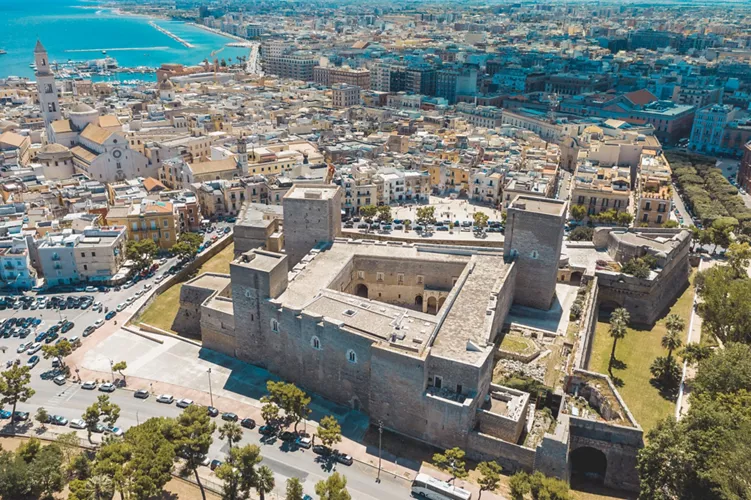This content was automatically translated. View the original text.

Overview
The Swabian castle of Bari, the court of two enlightened sovereigns
You can't say you know Bari if you don't visit its castle, the city's landmark building, close to the old town, between the old dockyard and the cathedral.
Commissioned by Emperor Frederick II in the 13th century on what remained of a Norman fortification, it was transformed several times, until in its golden age it became the seat of a refined Renaissance court ruled by two women.
Today it is home to a museum and the city's cultural centre.
A millennium-long walk
A visit to the impressive fortress surrounded by the moat that dominates the historic centre of Bari is a millennium-long walk in the company of great emperors and queens.
The central part is of Byzantine-Norman origin, but was completely transformed by Frederick II between 1233 and 1240, then restored by Charles of Anjou in the following century, while the sloping balustrades with corner towers were added in the Aragonese period during the 16th century.
When the Aragonese donated it to the Sforza ducal family, the fortress was enlarged and embellished by the intervention of two women, mother and daughter: Isabella of Aragon, widow of Gian Galeazzo Sforza, Duchess of Bari and Bona Sforza. The castle became the seat of a court that had nothing to envy from the Lords of the North. We owe them the scenic double flight of stairs connecting the ground floor to the halls of the piano nobile.
During Bourbon rule, the castle began a long period of decay and abandonment, during which it was used as a prison and barracks. Only recently, in 2017, after extensive restoration and enhancement work, was the castle opened to the public as a museum.
On the main floor, exhibitions and permanent displays
The main floor of the castle is divided into various halls that are used for temporary exhibitions, cultural events and for permanent displays: the Aragonese Hall houses a photographic exhibition on the history of the restoration of the castle; the Angevin wing houses the archaeological collection of tableware ceramics (15th-18th century) from the excavations of the "butto" (today we would call it a rubbish tip) that testify to an area of court life, while the so-called Torre dei Minorenni displays a collection of precious materials and jewellery from various places in Apulia.
The Gipsoteca of the Castle of Bari
The ground floor of the Castle, in the beautiful rooms with ogival arches, houses the Gipsoteca, an interesting collection of plaster reproductions of sculptures of some Apulian monuments made in 1911 by artists Pasquale Duretti and Mario Sabatelli for the Apulian pavilion at the Ethnographic Exhibition organised in Rome on the occasion of the 50th anniversary of the Unification of Italy.
For more information visit the official website
For more information visit the official website
Piazza Federico II di Svevia, 70122 Bari BA, Italia